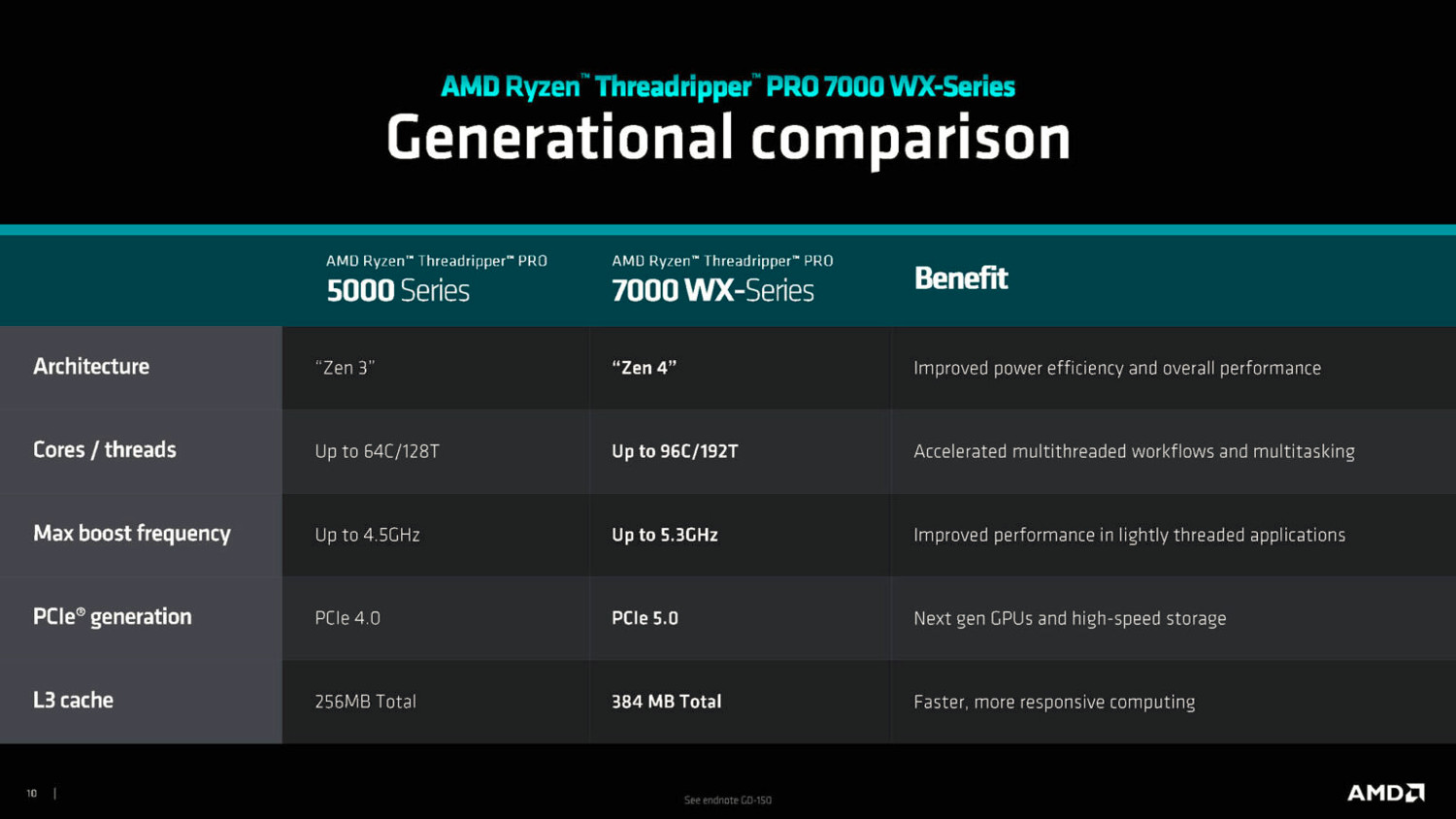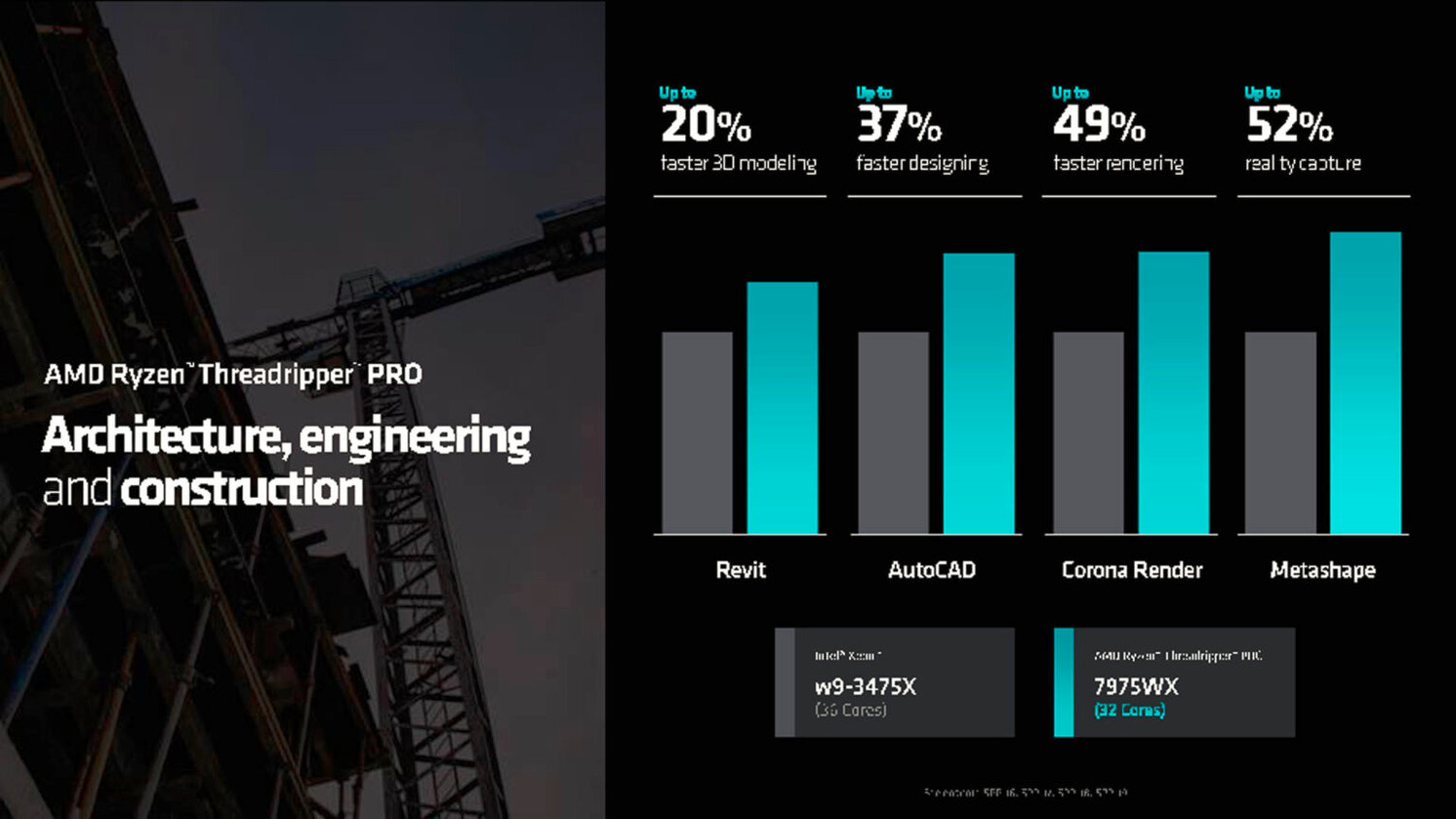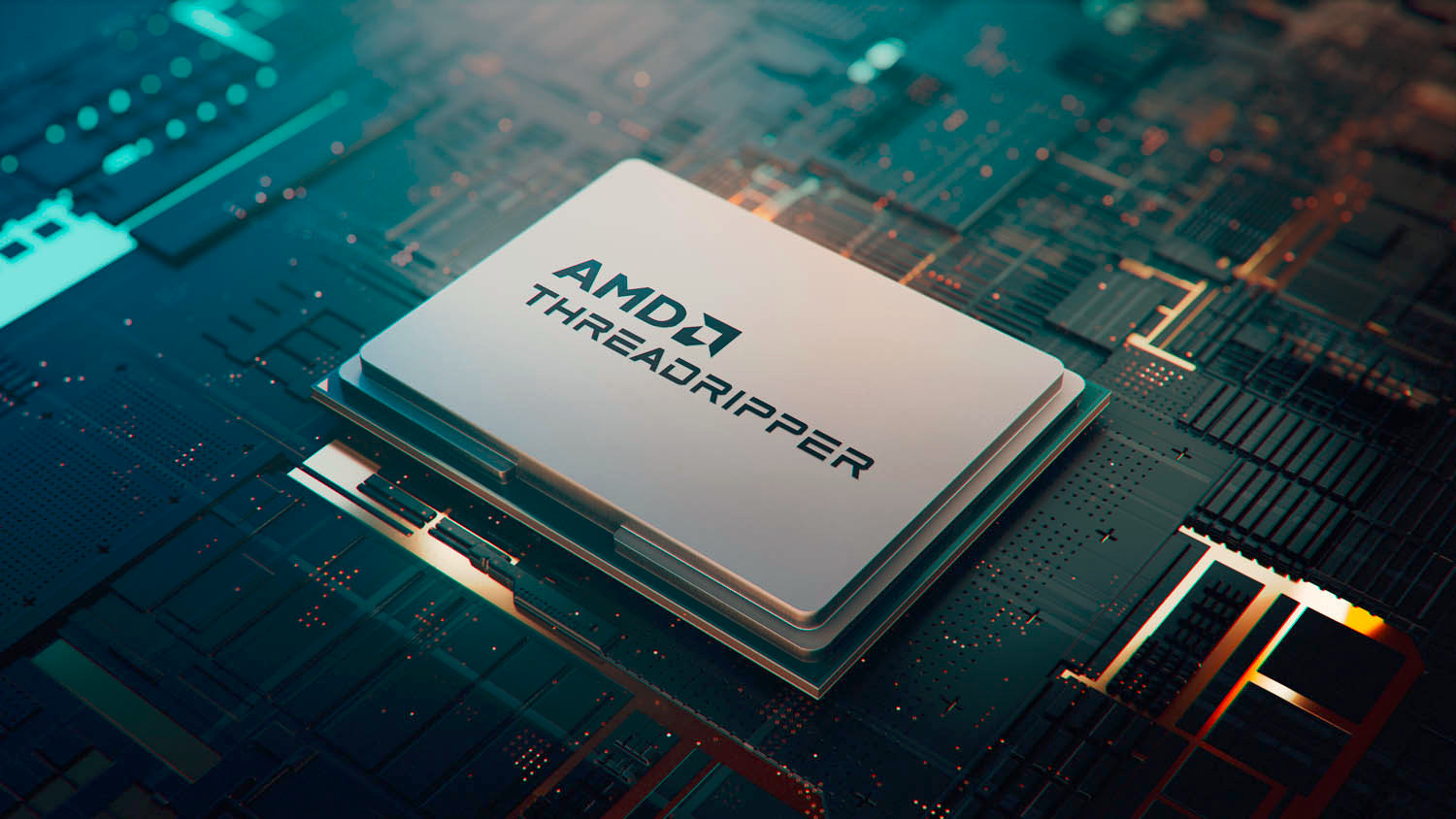With its new ‘Zen 4’ Threadripper processors, AMD looks set to rewrite the rule book for high-end workstations yet again, writes Greg Corke
It’s fair to say that AMD changed high-end workstations forever with its Threadripper processor. Starting out life in 2017 as a 16-core ‘prosumer’ or high-end desktop (HEDT) CPU, Threadripper came of age in 2020 with the launch of Threadripper Pro, a genuine workstation-class processor with up to 64 high-frequency cores, up to 2TB of 8-channel memory, tonnes of PCIe lanes and enterprise-level security and manageability.
And with this true Intel Xeon competitor came the major workstation OEMs. First Lenovo, then Dell, and now today, with the new Threadripper Pro 7000 WX-Series based on AMD’s ‘Zen 4’ architecture, finally HP.
While coveting the major workstation OEMs, AMD ignored the ‘prosumer’ or HEDT market, eventually making Threadripper only available as a ‘Pro’ variant with a suitable Pro sized price tag.
But this is no longer the case. With its new ‘Zen 4’ Threadripper processors, AMD is offering both ‘Pro’ (7000 WX-Series) and ‘HEDT’ (7000 Series) variants. And from what we’ve been shown by AMD, both product lines look hugely impressive.
Threadripper Pro 7000 WX-Series
AMD has made some rather big advancements over the previous generation ‘Zen 3’ Threadripper Pro 5000 WX-Series. Let’s look at each of these in turn.
Core count
The past two generations of Threadripper Pro maxed out at 64-cores, but the new Threadripper Pro 7000 WX-Series goes all the way up to 96. This alone should deliver a substantial performance improvement in highly multi-threaded workflows such as ray trace rendering and engineering simulation, including Computational Fluid Dynamics (CFD).
But that doesn’t mean that AMD is ignoring customers with workflows or budgets that are better suited to lower core count CPUs. Indeed, AMD offers a wide range of Threadripper Pro 7000 WX-Series chips with 12, 16, 24, 32, 64 or 96 cores.
But why would a customer go for a lower core count Threadripper Pro CPU when there are cheaper 12- and 16-core AMD Ryzen and AMD Ryzen Pro processors, based on the same ‘Zen 4’ architecture? The fact is that there are workflows, such as CFD, that benefit from Threadripper Pro’s significantly higher memory bandwidth or the ability of the platform to host more PCIe add-in boards, such as GPUs for rendering.


Higher frequencies
Base and boost frequencies on the Threadripper Pro 7000 WX-Series are significantly higher than the 5000 WX-Series. This should benefit everyone – those with highly multi-threaded workflows such as rendering as well as single threaded workflows such as CAD.
The 64-core Threadripper Pro 7985WX, for example, delivers 3.2 GHz base and 5.1 GHz boost, which is 0.5 GHz and 0.6 GHz faster than its ‘Zen 3’ equivalent, the Threadripper Pro 5995WX.
Even the top-end 96-Core 7995WX delivers a whopping 5.1 GHz boost, which is only 0.6 GHz behind AMD’s top-end consumer processor, the AMD Ryzen 9 7950X. These significant frequency gains are in part down to an increase in Thermal Design Power (TDP), going from 280W in the previous generation to 350W for all new Threadripper Pro 7000 WX-Series chips.
Higher IPC
All Threadripper Pro 7000 WX-Series chips get a significant boost simply because they are built on AMD’s newer Zen 4 architecture. Compared to Zen 3, AMD quotes a 13% uplift in Instructions Per Clock (IPC), the number of instructions a CPU can execute in a single clock cycle. This should benefit all multi-core and single core workflows.
DDR5 memory
The Threadripper Pro 7000 WX-Series supports eight memory channels, the same as the 5000 WX-Series, but now it’s 5,200 MHz DDR5 memory, rather than 3,200 MHz DDR4.
DDR5 memory delivers significantly more bandwidth than DDR4, which should bring big benefits to some memory intensive workflows such as engineering simulation. However, this probably won’t make a difference in many other workflows.
Incidentally, AMD decided not to go for 12-channel memory, a hallmark of its Zen 4 EPYC server processors. According to AMD, this is partly to tailor the platform to a workstation audience and partly because there is simply no room in a standard workstation chassis.
PCIe Gen 5
The new Threadripper Pro platform supports 128 PCIe Gen 5 lanes, which doubles the PCI bandwidth to any slot on the board compared to the previous generation with PCIe Gen 4. According to AMD, this should deliver real benefit to multi-GPU AI workflows. However, perhaps this is one for the future as most current pro GPUs, including the Nvidia RTX 6000 Ada and AMD Radeon Pro W7900, are still on PCIe Gen 4.
With 128 lanes, the platform can, in theory, support eight double slot GPUs. In reality this is less, as it’s decided by the motherboard manufacturers. Most of the major workstation OEMs support two or three double slot GPUs on their new Threadripper Pro machines, but we could see boards from specialist manufacturers that support more.
What about AMD 3D V-Cache?
A lot of what we see in the Threadripper Pro 7000 WX-Series is inherited from AMD’s ‘Zen 4’ EPYC server processors. Some of the more recent models from the EPYC 9004 Series come with 3D V-Cache, a special type of L3 cache that is stacked vertically instead of horizontally, so more cache can be placed on the CPU. The 96-core AMD EPYC 9684X, for example, boasts a whopping 1,152 MB compared to its non 3D V-Cache equivalent, the AMD EPYC 9654 which has 384 MB.
The benefit of having more cache is that the CPU has a greater chance of fetching the data it needs from faster cache instead of from slower system memory (RAM). And in some memory intensive workflows, such as CFD, where large amounts of data need to be fetched regularly, this can deliver a performance benefit, as demonstrated in DEVELOP3D’s review of the consumer-focused AMD Ryzen 7000 X3D processor, and in this blog post by Siemens about its CFD software Simcenter STAR-CCM+.
The Threadripper Pro 7000 WX-Series does not support 3D V-Cache. Instead, it comes with standard L3 cache up to 384 MB on the 96-core model. On a core-to-core basis this is the same as the previous generation.
AMD said that it experimented with 3D V-Cache on Threadripper but found that there are ‘very few applications that show a material performance uplift’. Enabling 3D V-Cache also means a small drop in frequency which would reduce performance in workflows that do not benefit from additional cache.
Performance improvements
As you would expect, with more cores, higher frequencies and higher IPC, AMD is quoting significant performance gains for the Threadripper Pro 7000 WX-Series compared to the previous generation Threadripper Pro 5000 WX Series.
Putting the number of cores to one side and only comparing 64-core models from both the Zen 4 and Zen 3 Threadripper Pros (7985WX vs 5995WX), AMD quotes considerable performance gains of up to: 31% in Unreal Engine; 39% in V-Ray (rendering); 27% in KeyShot (rendering); 46% in Ansys (simulation); 43% in Corona (rendering); 40% in Solidworks (CAD); 21% in Revit (BIM); and 31% in AutoCAD (CAD).
We would expect to see similar gains at all different core counts, and of course a much bigger leap when comparing the 96-core 7995WX to the 64-core 5995WX in highly multi-threaded applications like ray trace rendering.

The Intel Xeon W-3400 Series killer?
In our May/June 2023 Workstation Special report we put AMD up against Intel in high-end workstation CPUs, taking the top end models from AMD’s ‘Zen 3’ Threadripper Pro 5000 WX-Series and Intel’s ‘Sapphire Rapids’ Xeon W-3400 Series – the 64-core AMD Threadripper Pro 5995WX and 56-core Intel Xeon w9-3495X.
In summary, we found that AMD had a lead in highly multi-threaded workflows like ray trace rendering, while Intel had the edge in single threaded workflows like CAD, and sometimes quite a considerable advantage in memory bandwidth intensive workflows like CFD.
With the new Threadripper Pros it looks like this balance is set to shift completely in favour of AMD. With more cores, higher frequencies, better IPC and now with 8-channel DDR5 memory (similar to Intel), AMD is quoting significant performance gains across the board.
In the multi-threaded design viz tool, Chaos V-Ray, AMD says its 96-core Threadripper Pro 7995WX is up to 123% faster than the 56-core Intel Xeon w9-3495X. AMD is also quoting performance gains for processors with similar core counts. Comparing the 32-core Threadripper Pro 7975WX to the 36-core Intel Xeon w9-3475X, AMD says it is up to: 25% faster in PTC Creo (CAD); 39% faster in Ansys Mechanical (simulation); 44% faster in Luxion KeyShot (rendering); 45% faster in Solidworks (CAD); 20% faster in Revit (BIM); and up to 52% faster in MetaShape (reality capture).



Threadripper for ‘prosumers’
In order for AMD to be taken seriously in the workstation market and adopted by the major workstation OEMs, it not only needed great performance but a pro grade processor with Intel Xeon-like features such as security, manageability, lots of PCIe lanes and support for Error Correcting Code (ECC) memory (and lots of it).
This all led to the launch of Threadripper Pro in 2020. Soon after, AMD made the decision to phase out the consumer variant of Threadripper.
The problem was, consumer variants of Threadripper (or prosumer, enthusiast, HEDT – call them what you will) were much cheaper, and with top-end Threadripper Pro CPUs going for over £6,000 at one point, this put many of AMD’s high core count CPUs out of the reach of many content creators, 3D artists, photographers, or design viz studios.
For the ‘Zen 4’ launch AMD has made the surprise move to reintroduce an HEDT line up of Threadripper processors, which it is simply calling the Threadripper 7000 Series. These processors will be cheaper and so will the motherboards that house them.
The HEDT Threadrippers are very similar to their Pro counterparts in terms of clock speed and cache. However, the HEDT platform only supports 4-channel memory instead of 8-channel, so there’s less memory bandwidth; 48 PCIe 5.0 lanes instead of 128, so supports fewer GPUs; and it doesn’t have pro management features.
There are also fewer models to choose from – 64-core, 32-core, or 24-core. There is no 96-core model (so the ultimate performance crown remains with Threadripper Pro) and no 16-core or 12-core models, presumably because AMD feels that that part of the market is well covered by its consumer-focused Ryzen 7000 Series processors.



While the major workstations OEMs, including Dell, HP, and Lenovo, will continue to only offer Threadripper Pro, we expect the ‘HEDT’ Threadripper 7000 Series to be popular with specialist workstation manufacturers like Scan, BOXX, and Armari.
According to AMD, workstations with the HEDT processor can also be smaller thanks to ATX motherboards that have fewer PCIe slots than the EATX boards used for Threadripper Pro. And the motherboards and processors will also be cheaper. AMD says that most motherboards will support up to two GPUs and up to two NVMe SSDs.
Conclusion
On paper AMD’s new ‘Zen 4’ Threadrippers look to be incredible workstation processors, combining a phenomenal number of cores with boost frequencies not that far behind AMD’s best consumer CPUs. Five years ago, this was simply unimaginable.
Significant increases in core count, IPC and base frequency all look set to contribute to substantial double digit performance increases in both single threaded and multi-threaded workflows compared to the previous generation.
In addition, while the Intel Xeon W-3400 Series beat the previous generation AMD Threadripper Pro 5000 WX-Series in certain niche high-end workstation workflows, it’s now hard to imagine how Intel will compete on anything other than price/performance.
How much the new Threadripper Pro processors will cost is still unknown and while AMD could choose to place a big premium on its new chips, it could also choose to go aggressive on price to build market share. If that happens, perhaps we will even see the price of Intel Xeon processors fall?
Interestingly, AMD is also giving itself serious competition from within, with the re-introduction of an HEDT-focused Threadripper processor. While many larger design, engineering and architecture firms will only buy from major OEMs like Dell, HP and Lenovo, others are more flexible and the ‘HEDT’ Threadripper 7000 Series presents a big opportunity for specialist workstation manufacturers.
Yes, you get less memory channels and miss out on some pro features, but we expect performance in most rendering tools to be similar, if not better if machines are overclocked, something that the major OEMs simply won’t do. And of course, with lower-cost CPUs and motherboards, these workstations should be significantly cheaper.
We look forward to testing the new ‘Zen 4’ Threadripper CPUs soon.
Threadripper Pro – all the major workstation OEMs now on board
When AMD introduced 1st Generation Threadripper Pro (3000 WX-Series) in 2020, Lenovo broke the mould by becoming the first major workstation OEM in nearly 15 years to launch a workstation with an AMD CPU. Lenovo was rewarded by AMD with an exclusive agreement for Threadripper Pro and the Lenovo ThinkStation P620 became an instant success. It wasn’t until 2022 that Lenovo got some real competition when Dell came on board with 2nd Generation Threadripper Pro (5000 WX-Series).
At that point in time, considering AMD’s complete dominance over Intel in high-end workstation CPUs (Intel hadn’t released a major Xeon processor for several years), we were incredibly surprised that HP didn’t come on board too.
That all changes with the launch of 3rd Generation Threadripper Pro (7000 WX-Series). HP has finally joined Dell and Lenovo, with AMD now having all three major workstation manufacturers on board. Considering where AMD was just five years ago, this is major news.
So far, only Dell and HP have released details of their new Threadripper Pro 7000 WX-Series workstations. We expect Lenovo to follow soon.
The underlying theme for the Dell Precision 7875 and HP Z6 G5 A is that both workstations are positioned in the middle of their respective product stacks, alongside and below machines that carry Intel Xeon W-3400 processors with up to 56-cores.
This positioning is dictated primarily by the expandability, serviceability and size of the machines, and not necessarily by the performance of Threadripper Pro.
For example, neither vendor is making full use of Threadripper Pro’s 128 PCIe lanes, with Dell supporting up to two double height GPUs and HP supporting up to three.
By having fewer PCI slots, Dell and HP can reduce the size of the motherboard, PSU and chassis, which all help bring down the base cost of the systems. But even with this ‘mid-range’ positioning, as Threadripper Pro is available from 12 to 96 cores, both machines are capable of supporting a huge range of workflows, from entry-level to high end. And having a single product that can cover so many bases is always good news for the IT departments that manage these machines.

HP Z6 G5 A
The HP Z6 G5 A shares a similar name to the Intel Xeon-based HP Z6 G5, but the A suffix refers to ‘AMD’. Both chassis are the same size, but the Threadripper Pro version has a different industrial design, better airflow, and four front-accessible NVMe drives, which are hot-swappable and lockable.
HP offers the entire Threadripper Pro 7000 WX-Series CPU stack up to 96-cores, can support three double height GPUs, up to 1 TB of memory, 12 SSDs and two HDDs. In terms of positioning, it sits beneath the HP Z8 Fury G5, which supports an Intel Xeon W-3400 Series processor up to 56-cores and up to four double height GPUs.
For datacentres, the machine is 4U in size and comes with an optional rack mount kit, and optional HP Anyware Remote System Controller. This PCIe add-in card is designed to give the workstation server level management capabilities. The idea is to help IT managers better manage fleets of workstations, allowing them to remote in, power workstations on and off remotely, perform bare metal imaging (with multiple Operating Systems) manage inventory, and get hardware alerts and diagnostics info.

Dell Precision 7875
The Dell Precision 7875 replaces the Dell Precision 7865, Dell’s first generation Threadripper Pro workstation. The chassis is a little deeper and taller than its predecessor, so there is more airflow to handle the increased TDP of the Zen 4 processors (350W compared to 280W). It also offers one additional PCIe slot, taking the total to six, although it supports same number of double height GPUs (two).
The Precision 7875 offers the entire Threadripper Pro 7000 WX-Series CPU stack from 12- to 96-cores, up to 2 TB of DDR5 memory, and up to six storage devices, including two front accessible NVMe SSDs. In terms of positioning, it sits between the Dell Precision 5860 (Intel Xeon W-2400 up to 24-cores and two double height GPUs) and Dell Precision 7960 Tower (Intel Xeon W-3400 up to 56-cores and four double height GPUs).
The 4U machine can also be rack mounted. According to Dell, this is a little bit easier to do than with its predecessor because you can directly mount rack rails to the chassis without having to use an extension.






